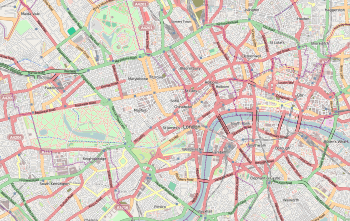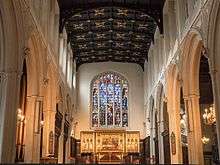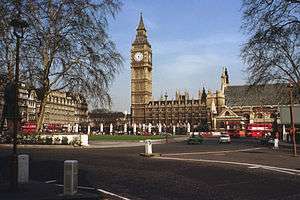St Margaret's, Westminster
The Church of St Margaret, Westminster Abbey, in the grounds of Westminster Abbey on Parliament Square, London, England, was, until 1972, the Anglican parish church of the House of Commons.[1] It is dedicated to Margaret of Antioch,[2] and forms part of a single World Heritage Site with the Palace of Westminster and Westminster Abbey.
| St Margaret's, Westminster | |
|---|---|
.jpg) St Margaret's Church, Westminster, with the Elizabeth Tower of the Palace of Westminster in the background. | |
| Location | City of Westminster, London, UK |
| Coordinates | 51°30′00″N 00°07′37″W |
| Founded | 12th Century |
| Rebuilt | 1486 to 1523 |
| Official name: Palace of Westminster, Westminster Abbey and Saint Margaret's Church | |
| Type | Cultural |
| Criteria | i, ii, iv |
| Designated | 1987 (11th session) |
| Reference no. | 426 |
| Country | United Kingdom |
| Region | Europe and North America |
 Location of St. Margaret, Westminster Abbey in central London | |
History and description
The church was founded in the twelfth century by Benedictine monks, so that local people who lived in the area around the Abbey[3] could worship separately at their own simpler parish church, and historically it was within the hundred of Ossulstone in the county of Middlesex.[4] In 1914, in a preface to Memorials of St. Margaret's Church, Westminster, a former Rector of St Margaret's, Dr Hensley Henson, reported a mediaeval tradition that the church was as old as Westminster Abbey, owing its origins to the same royal saint, and that "The two churches, conventual and parochial, have stood side by side for more than eight centuries — not, of course, the existing fabrics, but older churches of which the existing fabrics are successors on the same site."[5]
St Margaret's was rebuilt from 1486 to 1523, at the instigation of King Henry VII, and the new church, which largely still stands today, was consecrated on 9 April 1523. It has been called "the last church in London decorated in the Catholic tradition before the Reformation", and on each side of a large rood there stood richly painted statues of St Mary and St John, while the building had several internal chapels. In the 1540s, the new church came near to demolition, when Edward Seymour, 1st Duke of Somerset, planned to take it down to provide good-quality materials for Somerset House, his own new palace in the Strand. He was only kept from carrying out his plan by the resistance of armed parishioners.[6]
In 1614, St Margaret's became the parish church of the Palace of Westminster, when the Puritans of the seventeenth century, unhappy with the highly liturgical Abbey, chose to hold their Parliamentary services in a church they found more suitable:[7] a practice that has continued since that time.
Between 1734 and 1738, the north-west tower was rebuilt to designs by John James; at the same time, the whole structure was encased in Portland stone. Both the eastern and the western porch were added later, with J. L. Pearson as architect. In 1878, the church's interior was greatly restored and altered to its current appearance by Sir George Gilbert Scott, although many Tudor features were retained.[8]
By the 1970s, the number of people living nearby was in the hundreds. Ecclesiastical responsibility for the parish was reallocated to neighbouring parishes by the Westminster Abbey and Saint Margaret Westminster Act 1972, and the church was brought under the authority of the Dean and Chapter of Westminster Abbey.[1]
An annual new year service for the Coptic Orthodox Church in Britain takes place in the church in October, and in 2016 Bishop Angaelos gave the sermon.[9]
The Rector of St Margaret's is often a canon of Westminster Abbey.[10]
Commemorative windows

Notable windows include the east window of 1509 of Flemish stained glass, created to commemorate the betrothal of Catherine of Aragon to Henry VIII.[11] This has had a chequered history. It was given by Henry VII to Waltham Abbey in Essex, and at the Dissolution of the Monasteries the last Abbot sent it to a private chapel at New Hall, Essex. That came into the possession of Thomas Boleyn, 1st Earl of Wiltshire, the father of Anne Boleyn, then Thomas Radclyffe, 3rd Earl of Sussex, next George Villiers, 1st Duke of Buckingham, after him Oliver Cromwell, from whom it reverted to the second Duke of Buckingham, next General Monk, Duke of Albemarle, and after him John Olmius, then Mr Conyers of Copt Hall, Essex, whose son sold the window to the parish of St Margaret's in 1758, for four hundred guineas. The money came from a grant of £4,000 which parliament had made to the parish that year for the renovation of the church and the rebuilding of the chancel.[12]
Other windows commemorate William Caxton, England's first printer, who was buried at the church in 1491, Sir Walter Raleigh, executed in Old Palace Yard[13] and then also buried in the church in 1618, the poet John Milton, a parishioner of the church, and Admiral Robert Blake.
Weddings
As well as marrying its own parishioners, the church has long been a popular venue for society weddings, as Members of Parliament, peers, and officers of the House of Lords and House of Commons can choose to be married in it. Notable weddings include:
- 5 July 1631: Edmund Waller and Anne Banks, who was an heiress and a ward of the Court of Aldermen, were married at the church in defiance of orders of the Court and the Privy Council of England. Waller had previously carried the bride off and been forced to return her. On a complaint being made to the Star Chamber, Waller was pardoned by King Charles I.[14]
- 1 December 1655: Samuel Pepys and Elisabeth Marchant de St. Michel[15]
- 12 November 1656: John Milton and Katherine Woodcock[16]
- 12 June 1895: William Hicks and Grace Lynn Joynson
- 12 September 1908: Winston Churchill and Clementine Hozier[17]
- 21 April 1920: Harold Macmillan, and Lady Dorothy Cavendish[18]
- 18 July 1922: Lord Louis Mountbatten, and Edwina Ashley
- 8 October 1993: David Armstrong-Jones, Viscount Linley, and the Hon. Serena Stanhope
Other notable weddings include some of the Bright Young People.[19]
Baptisms
- Charles Weston, 3rd Earl of Portland, 19 May 1639[20]
- Barbara Villiers, only child of Lord Grandison and a future royal mistress of King Charles II, was christened in the church on 27 November 1640.[21]
- Charles Montagu, 1st Earl of Halifax, was christened in the church on 12 May 1661[22]
- Charles FitzRoy, 2nd Duke of Cleveland, eldest son of Barbara Villiers, was christened in the church on 16 June 1662, when the father's name was given as her husband, Lord Castlemaine, instead of as the King, who later acknowledged the child as his. In October 1850 The Gentleman's Magazine reported this entry and claimed it as "an untruth" and "a new fact in the secret history of Charles II".[22]
- Thomas Pelham-Clinton, 3rd Duke of Newcastle, 28 July 1752[23]
- Olaudah Equiano, an African slave, was christened as Gustavus on 9 February 1759, when he was described in the parish register as "Gustavus Vassa a Black born in Carolina 12 years old".[24]
Burials
- William Caxton, 1491[12]
- John Sutton, 3rd Baron Dudley, "Lord Quondam", 18 September 1553; and his wife Lady Cicely Grey, 28 April 1554
- Nicholas Ludford, 1557
- Blanche Parry, 1590
- Sir Walter Raleigh, 1618
- William Murray, 2nd Earl of Tullibardine, 30 July 1627
- Edward Grimeston, 14 December 1640
- Following the Restoration of the Monarchy, in 1661 several Parliamentarians who had been buried in Westminster Abbey, Admiral Robert Blake, Denis Bond, Nicholas Boscawen,[25] Mary Bradshaw, Sir William Constable, Admiral Richard Deane, Isaac Dorislaus, Anne Fleetwood, Thomas Hesilrige, Humphrey Mackworth, Stephen Marshall, Thomas May, John Meldrum, Admiral Edward Popham, John Pym, Humphrey Salwey, William Strong, William Strode, and William Twisse, were all disinterred from there and reburied in an unmarked pit in St Margaret's churchyard, on the orders of King Charles II. A memorial to them is set into the external wall to the left of the main west entrance.[26]
- Mary [Davies] [Born 1675] Widow of Sir Thomas Grosvenor, 3rd Baronet; she is buried in the courtyard close to the north porch of the church
- Wenceslas Hollar, March 1677
- John West, 6th Baron De La Warr, 1723
- Bishop Nicholas Clagett, 1746
- Elizabeth Elstob, an early feminist, 1756.[27]
- Henry Constantine Jennings, 1819 [28]
- Thomas Churchyard, 1604, Elizabethan poet , soldier and courtier
- Jeremy Thorpe, former leader of the Liberal Party (funeral).
- Ignatius Sancho, composer, writer, slave abolitionist[29]
Other notable events
On Easter day in 1555 a former Benedictine monk, William Flower entered the church and attacked a priest who was administering the sacrament. Although he repented for the injury he caused the priest, Flower would not repent his motive which was based on a rejection of the doctrine of transubstantiation. He was thus sentenced for heresy and burned at the stake outside the church.
During the First World War, Edward Lyttelton, headmaster of Eton, gave a sermon in the church on the theme of "Loving your enemies", promoting the view that any post-war treaty with Germany should be a just one and not vindictive. He had to leave the church after the service by a back door, while a number of demonstrators sang "Rule Britannia" in protest at his attitude.[30]
Choirs
The treble choristers for St Margaret's are supplied by Westminster Under School. The church also hosted the first performance by the UK Parliament Choir under Simon Over in 2000.
Organ
An organ was installed in 1806 by John Avery. The current organ is largely built by J. W. Walker & Sons Ltd. A specification of the organ can be found on the National Pipe Organ Register.[31]
Rectors
Mackenzie Walcott lists the following as officiating clergymen:[32]
- c. 1503 Sir John Conyers, curate
- c. 1509 Sir John Symes, curate
- c. 1519 Mr. Hall, curate
- c. 1521 Sir Robert Danby, curate
- c. 1530 William Tenant, curate
- 1594 William Drap
- c. 1610 William Murrey
- c. 1621 Prosper Styles, curate
- c. 1622 Isaac Bargrave, minister
- c. 1638 Gilbert Wymberly, minister
- 1640 Stephen Marshall, lecturer
- 1642 Samuel Gibson
- 1644 Mr. Eaton, minister
- 1649 John Binns
- 1657 Mr. Wyner / Mr. Warmstree, lecturer
- 1661 William Tucker, curate
- c. 1670 William Owtram (also minister in 1664[33])
- 1679–1683 Thomas Sprat
- 1683–1724† Nicholas Onley[34]
- 1724–1730† Edward Gee
- 1730–1734 James Hargrave
- 1734–1753† Scawen Kenrick
- 1753–1784† Thomas Wilson
- 1784–1788† John Taylor[35]
- 1788–1796† Charles Wake
- 1796–1827† Charles Fynes-Clinton
- 1828–1835 James Webber
Under the Ecclesiastical Commissioners Act 1840, the rectory of St Margaret's was annexed to the canonry of Westminster Abbey held by Henry Hart Milman, such that Milman and his successors as Canon would be Rector ex officio.[36] This arrangement continued until 1978. The Rector was often (and continuously from 1972 to 2010) also the Chaplain to the Speaker of the House of Commons.[37]
- 1835–1849 Henry Hart Milman
- 1849–1864† William Cureton
- 1864–1876† William Conway
- 1876–1895 Frederic Farrar (also Speaker's Chaplain from 1890)[38]
- 1895–1899 Robert Eyton[39]
- 1899–1900 Joseph Armitage Robinson[40]
- 1900–1912 Hensley Henson[41]
- 1912–1936† William Hartley Carnegie[42] (also Speaker's Chaplain from 1916)
- 1936–1940† Vernon Storr
- 1941–1946 Alan Don (also Speaker's Chaplain since 1936)
- 1946–1956 Charles Smyth
- 1957–1969 Michael Stancliffe (also Speaker's Chaplain from 1961)
- 1970–1978 David Edwards (also Speaker's Chaplain from 1972)
- 1978–1982 John Baker (also Speaker's Chaplain)
- 1982–1987 Trevor Beeson (also Speaker's Chaplain)
- 1987–1998 Donald Gray (also Speaker's Chaplain)
- 1998–2010 Robert Wright (also Speaker's Chaplain)
- 2010–2016 Andrew Tremlett
- 2016– Jane Sinclair[43]
Organists
Organists who have played at St Margaret's include:
- Robert Whyte 1570–1574
- John Egglestone
- John Parsons 1616–1621 (then organist of Westminster Abbey)[44]
- John Hilton 1628 – 1657(?)
- John Blow, 1695–????
- Bernard Smith, 1676–1708
- Henry Turner 1708–????
- John Illam ????–1726
- Edward Purcell, son of Henry Purcell, 1726–1740
- James Butler 1740 – 1772
- William Rock 1774 – 1802
- Michael Rock 1802 – 1809
- John Bernard Sale 1809 – 1838
- T.G. Baines around 1864 [45]
- Walter Galpin Alcock ???? – 1896
- Edwin Lemare 1897 – 1902
- Reginald Goss-Custard 1902 – 1914
- Edwin Stephenson 1914 – 1922 (formerly organist of St Philip's Cathedral, Birmingham)
- Herbert Dawson 1929 – 1965
- Martin Neary 1965 – 1972
- Richard Hickox 1972 – 1982
- Thomas Trotter
- Simon Over 1992 – 2002
Gallery
 Explanatory plaque
Explanatory plaque St Margaret's Church. To the left is the Elizabeth Tower of the Palace of Westminster; to the right is the Abbey.
St Margaret's Church. To the left is the Elizabeth Tower of the Palace of Westminster; to the right is the Abbey. St Margaret's, seen from the London Eye Ferris wheel
St Margaret's, seen from the London Eye Ferris wheel The nave of St Margaret's
The nave of St Margaret's
References
- Westminster Abbey. "St. Margaret's, Westminster Parish details". Archived from the original on 5 March 2008. Retrieved 3 May 2008.
- Pevsner, N.; Bradley, Simon (2003). The Buildings of England: London 6 – Westminster. Uxbridge: Penguin. ISBN 0-300-09595-3.
- McManus, Mark. "St. Margaret's, Westminster". Archived from the original on 11 June 2008. Retrieved 3 May 2008.
- Hawgood, David. "St. Margaret's, Westminster". Genuki (Genealogy UK & Ireland). Retrieved 3 May 2008.
- From "Memorials of St. Margaret's church, Westminister, comprising the parish registers, 1539-1660, and other churchwardens' accounts, 1460-1603", reported in Notes and Queries (1914), p. 518
- John Richardson, The Annals of London: a Year-by-year Record of a Thousand Years of History (University of California Press, 2000), p. 81
- Wright, A.; Smith, P. (1868). Parliament Past and Present. London: Hutchinson & Co.
- Scott, George Gilbert (1995) [1879]. Stamp, Gavin (ed.). Personal and Professional Recollections. [London: Sampson Low, Marston, Searle & Rivington] Stamford: Paul Watkins Publishing. ISBN 1-871615-26-7.
- Messages from Prince of Wales, politicians, church leaders at Coptic New Year Service, Westminster Abbey dated 24 October 2016, at indcatholicnews.com, accessed 12 January 2018
- "Interview: Robert Wright, Sub-dean of Westminster Abbey, Rector of St Margaret's". Church Times. 26 May 2009. Retrieved 28 July 2018.
- Dean and Chapter, Westminster Abbey. "St Margaret's Church – The east window". St Margaret's Church. Retrieved 21 October 2010.
- H. B. Wheatley, Peter Cunningham, London Past and Present: Its History, Associations, and Traditions, p. 467
- Smith, Christopher. "Sir Walter Raleigh – Execution". Britannia Biographies. Retrieved 3 May 2008.
- R. E. C. Waters, Genealogical memoirs of the extinct family of Chester of Chicheley p. 91
- Pepys, Samuel (1987). Samuel Pepys (ed.). The Illustrated Pepys: extracts from the Diary. Harmondsworth: Penguin. ISBN 0-14-139016-6.
- 'Milton, John', in Journal of the Society of Arts dated 8 November 1867, p. 755
- Gilbert, Martin (1991). Churchill: a life. London: Heinemann. ISBN 0-434-29183-8.
- Taylor, D. J. (2007). Bright Young Things: the lost generation of London's Jazz Age. London: Chatto & Windus. ISBN 0-7011-7754-3. (American ed.: Farrar, Straus, and Giroux, New York, 2009)
- Robert Edmond Chester Waters, Genealogical memoirs of the extinct family of Chester of Chicheley (1878), p. 105
- Maurice Petherick, Restoration Rogues (1951), p. 327
- The Gentleman's Magazine, Volume 189 (1850), pp. 367, 368
- William Coxe, Memoirs of the Administration of the Right Honourable Henry Pelham Volume 1 (London: Longman, Brown, Rees, Orme & Green, 1829), p. xxx
- Felicity Nussbaum, ed., The Global Eighteenth Century (2005), p. 232
- http://www.westminster-abbey.org/our-history/people/nicholas-boscawen
- Oliver Cromwell Westminster Abbey
- John Chambers, Biographical Illustrations of Worcestershire (1820), p. 347
- E. Angelicoussis, "Jennings, Henry Constantine (1731–1819)" in Oxford Dictionary of National Biography (Oxford University Press, 2004, ISBN 0-19-861411-X
- Westminster Abbey. "Ignatius Sancho". Westminster Abbey. Retrieved 3 July 2020.
- Alan Wilkinson, The Church of England and the First World War (London, SCM Press, 1996), p. 221
- "NPOR D01260". National Pipe Organ Register. British Institute of Organ Studies. Retrieved 7 July 2020.
- Walcott, Mackenzie Edward Charles (1847). The History of the Parish Church of Saint Margaret, in Westminster. Westminster: W. Blanchard & Sons. p. 84. Retrieved 11 September 2019.
- J. L. Chester, The Marriage, Baptismal, and Burial Registers of the Collegiate Church or Abbey of St. Peter, Westminster, Volume 10 (Harleian Society, 1876), p. 197
- "Onley, Nicholas (ONLY671N)". A Cambridge Alumni Database. University of Cambridge.
- Courtney, William Prideaux (1898). . In Lee, Sidney (ed.). Dictionary of National Biography. 55. London: Smith, Elder & Co.
- "Ecclesiastical Commissioners Act 1840: Section 29", legislation.gov.uk, The National Archives, 1840 c. 113 (s. 29)
- "Speaker's Chaplain". The Church in Parliament. Church of England. Retrieved 5 September 2014.
- "Farrar, Frederic William (FRR849FW)". A Cambridge Alumni Database. University of Cambridge.
- "No. 26686". The London Gazette. 6 December 1895. p. 7063.
- "The Deanery of Westminster". The Times (36897). London. 13 October 1902. p. 9.
- "Bishop Hensley Henson – Master of Dialectic", obituary in The Times, 29 September 1947, p. 27
- "William and Mary Carnegie". Westminster Abbey. Retrieved 8 August 2014.
William Hartley Carnegie Canon of Westminster and Rector of St Margaret's 1913–1936. Sub Dean 1919–1936. Born 27 February 1859. Died 18 October 1936. ...
- Westminster Abbey — Sinclair appointed Rector of St Margaret's (Accessed 23 February 2016)
- Dwight's Journal of Music, p. 331
- William Charles Pearce,A Biographical Sketch of Edmund Hart Turpin, 1911
External links
| Wikimedia Commons has media related to St Margaret's, Westminster. |

